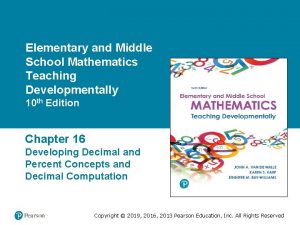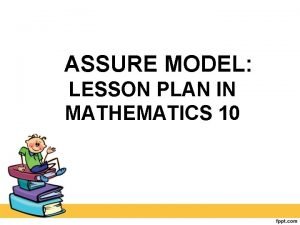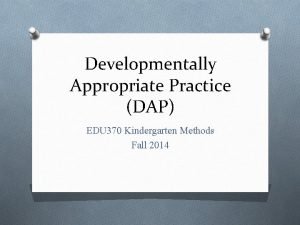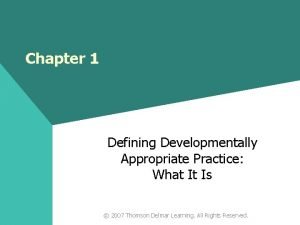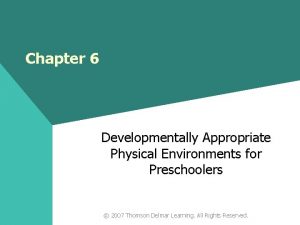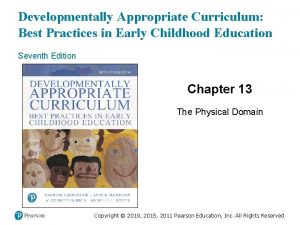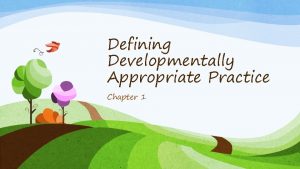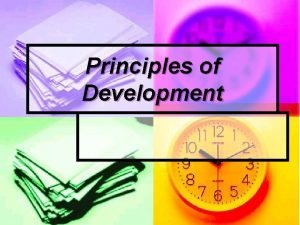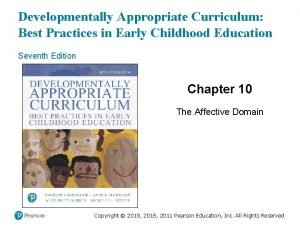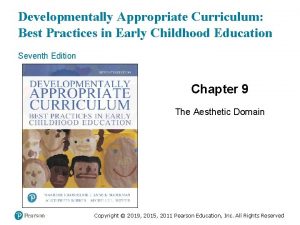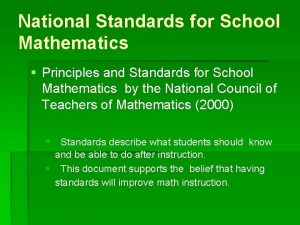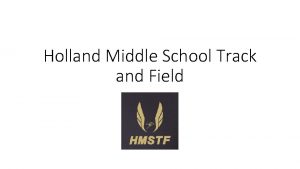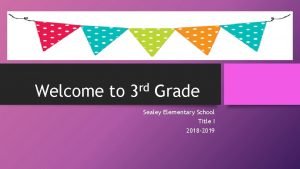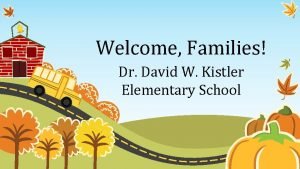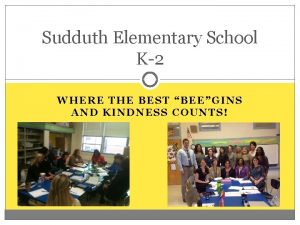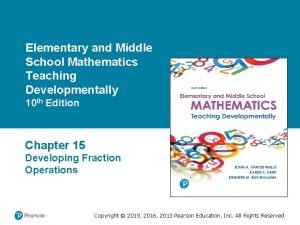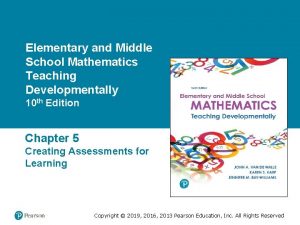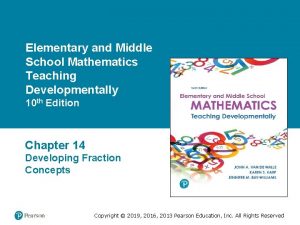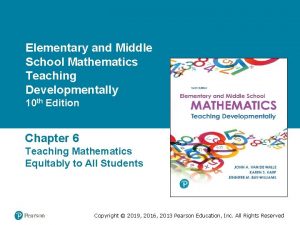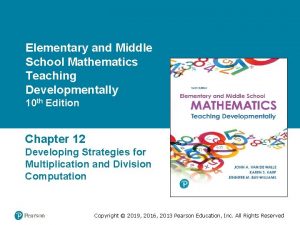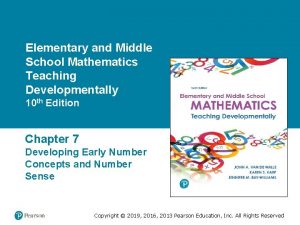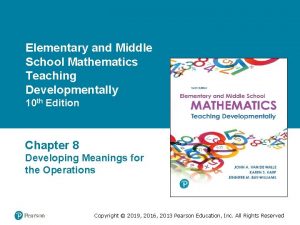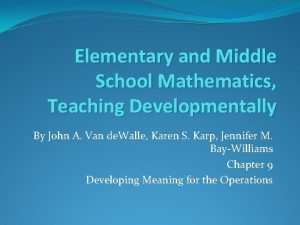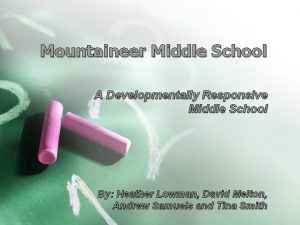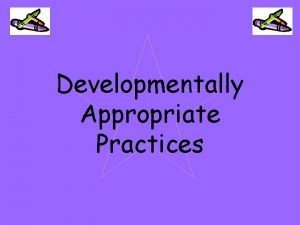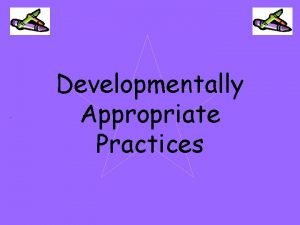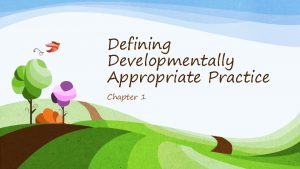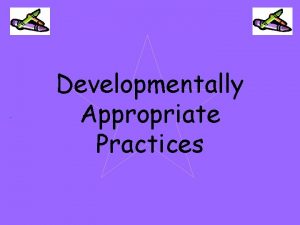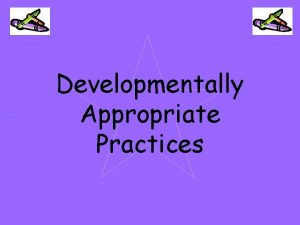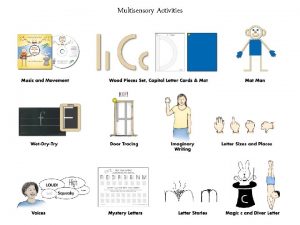Elementary and Middle School Mathematics Teaching Developmentally 10


























- Slides: 26

Elementary and Middle School Mathematics Teaching Developmentally 10 th Edition Chapter 13 Algebraic Thinking, Equations, and Functions Copyright © 2019, 2016, 2013 Pearson Education, Inc. All Rights Reserved

Learner Outcomes 13. 1 Describe ways to connect number and algebraic thinking, including using properties of the operations to build number sense and procedural fluency. 13. 2 Illustrate and describe how to infuse teaching of patterns and functions in K– 8. 13. 3 Identify strategies that can builds strong understanding of equivalence, recognizing the challenges students have with symbols (e. g. , equal and inequalities signs and variables). 13. 4 Define mathematical modeling and describe gradeappropriate examples of it. Copyright © 2019, 2016, 2013 Pearson Education, Inc. All Rights Reserved

Standards-Based Development Kindergarten students represent addition and subtraction with objects, fingers, mental images, drawings and sounds, acting out situations, giving verbal explanations, and using expressions and equations. Elementary students are capable of understanding and applying significant algebraic ideas including connections between arithmetic and algebra and functional thinking. Middle school students study algebra in more abstract and symbolic ways, focusing on understanding and using variables, expression and equations Grade 8 -Functions Copyright © 2019, 2016, 2013 Pearson Education, Inc. All Rights Reserved

Strands of Algebraic Thinking Research suggests three strands of algebraic reasoning, all infusing the central notions of generalization and symbolization: 1. Study of structures in the number system “algebra as generalized arithmetic” 2. Study of patterns, relations and functions 3. Process of mathematical modeling, including the meaningful use of symbols (esp. the equal sign) Algebra must be presented in a way that students see it as a useful tool for making sense of all areas of mathematics and real-world situations. Copyright © 2019, 2016, 2013 Pearson Education, Inc. All Rights Reserved

Connecting Number and Algebra Number Combinations - Looking for generalizations begins early with decomposition of numbers. Seven birds have landed in your backyard, some landed on a tree and some are at your feeder. How many birds might be in the tree and how many at the feeder? Place Value Relationships. The sum of 49 +18 can be found with the use of a hundreds chart. Moves on the chart can be recorded with arrows for up and down (down 1, right 8) Algorithms - Shifts in how arithmetic problems are presented can open up opportunities for generalizations. Sets of problems are good ways for students to look for and describe patterns and build understanding for the operation Copyright © 2019, 2016, 2013 Pearson Education, Inc. All Rights Reserved

• 49 + 18 • 15 + 23 • 57 – 14 • 82 – 39 Copyright © 2019, 2016, 2013 Pearson Education, Inc. All Rights Reserved

Properties of the Operations (1 of 2) Addition Properties of the Operations Name of Property Symbolic Representation How a Student Might Describe the Pattern or Structure Commutative a+b=b+a “When you add two numbers in any order you will get the same answer. ” Associative (a + b) + c = a + (b + c) “When you add three numbers you can add the first two and then add the third or add the last two numbers and then add the first number. Either way you will get the same answer. ” Additive Identity a+0=0+a=a “When you add zero to any number you get the same number you started with. ” Additive Identity a− 0=a “When you subtract zero from any number you get the number you started with. ” Additive Inverse a − a = a + (−a) = 0 “When you subtract a number from itself you get zero. ” Inverse Relationship of Addition and Subtraction If a + b = c then c − b = a and c − a = b “When you have a subtraction problem you can ‘think addition’ by using the inverse. ” Copyright © 2019, 2016, 2013 Pearson Education, Inc. All Rights Reserved

Properties of the Operations (2 of 2) Multiplication Properties of the Operations Name of Property Symbolic Representation How a Student Might Describe the Pattern or Structure Commutative a×b=b×a “When you multiply two numbers in any order you will get the same answer. ” Associative (a × b) × c = a × (b × c) “When you multiply three numbers you can multiply the first two and then multiply the answer by the third or multiply the last two numbers and then multiply the answer by the first number. Either way you will get the same answer. ” Multiplicative Identity a× 1=1×a=a “When you multiply one by any number you get the same number you started with. ” Multiplicative Inverse a times start fraction 1 over a end fraction = start fraction 1 over “When you multiply a number by its reciprocal, you will get one. ” Inverse Relationship of Multiplication and Division If a × b = c then c ÷ b = a and c÷a=b “When you have a division problem you can ‘think multiplication’ by using the inverse. ” Distributive (Multiplication over Addition) a times left parenthesis bnthesis = a times b + a times c “When you multiply two numbers, you can split one number into two parts (7 can be 2 + 5), multiply each part by the other number, and then add them together. ” Copyright © 2019, 2016, 2013 Pearson Education, Inc. All Rights Reserved

Applying the Properties of Addition and Multiplication At the heart of what it means to do mathematics is noticing generalizable properties like 1 + 6 = 6 + 1, as well as exploring odd and even numbers to generalize mathematical relationships. Justifying a conjecture provides exploration of the number system. Copyright © 2019, 2016, 2013 Pearson Education, Inc. All Rights Reserved

Study of Patterns and Functions (1 of 5) Repeating patterns: • Patterns that have a core that repeats • It’s important that students identify the core of the pattern • Repeating patterns in seasons, days of week, simple singing do, mi, do, mi Copyright © 2019, 2016, 2013 Pearson Education, Inc. All Rights Reserved

Study of Patterns and Functions (2 of 5) Growing or sequence patterns: Explore patterns that involve a progression from step to step (sequences). Analyzing how the pattern is changing Look at the visuals and then reasoning about the numerical relationship. Extend to nth case Copyright © 2019, 2016, 2013 Pearson Education, Inc. All Rights Reserved

Study of Patterns and Functions (3 of 5) Three types of patterns: Recursive – How a pattern changes from step to step, x to x and y to y Covariational thinking – How 2 quantities vary in relation, e. g. , As a step increases by 1, the number of tiles in T goes up by 3. Support student development of functional thinking: What is changing, what is staying the same? What quantities are you comparing? How could you organize your information in a table? Explicit relationship – A correlation between two quantities expressed in How might the quantities be a function rule. Look across the table represented in a graph? to see how to use the input to generate the output How can you represent the rule in words? In symbols? 3 x+1 Copyright © 2019, 2016, 2013 Pearson Education, Inc. All Rights Reserved

Study of Patterns and Functions (4 of 5) Growing patterns represented by 1. Physical models 2. Table 3. Words 4. Symbols 5. Graph Copyright © 2019, 2016, 2013 Pearson Education, Inc. All Rights Reserved

Study of Patterns and Functions (5 of 5) Table 13. 2 Characteristics of Functions Concepts Description Example Independent and dependent variables The independent variable is the input, or whatever value is being used to find another value. The dependent variable represents the output. In the “Pattern Blocks Perimeter” problem, the independent variable is the number of blocks in the string; the dependent variable is the perimeter. You can say that the perimeter of the block structure depends on the number of blocks used. Discrete and continuous functions When isolated or selected values are the only ones appropriate for a context, the function is discrete. If all values along a line or curve are solutions to the function, then the function is continuous. Discrete: “Pattern Blocks Perimeter” problem. Only whole-number values make sense. Continuous: Walking rate, where at any given time, there is a distance walked (even if that distance is 0 meters). Domain and range The domain of a function comprises the possible values for the independent variable. The range is the corresponding possible values for the dependent variable. In the “Pattern Blocks Perimeter” problem, the domain and range are all positive whole numbers. Copyright © 2019, 2016, 2013 Pearson Education, Inc. All Rights Reserved

Activity 13. 9 Sketch-a-Graph Materials - Graph paper Directions - Sketch a graph to match the following situations - Do not label. • The temperature of a frozen dinner 30 minutes before removed from the freezer until removed from the microwave and placed on the table. • The value of a 1970 Volkswagen Beetle from the time it was purchased to the present. • The level of water in the bathtub from the time you begin to fill it to the time it is completely empty after your bath. • Profit in terms of number of items sold • The height of a thrown baseball from when it is released to the time it hits the ground • Speed of the same baseball versus time Exchange to see if students can match a rough graph to each situation. Copyright © 2019, 2016, 2013 Pearson Education, Inc. All Rights Reserved

Linear Functions Linear and quadratic functions are special and common types of functions. Miah has 24 yards of fence to build a rectangular pen. She is considering what dimensions to build it and wants to analyze it algebraically. (1) Write an equation to describe the relationship between the length and width. (2) Write an equation to describe the relationship between the length and the area. Rate of Change and Slope Copyright © 2019, 2016, 2013 Pearson Education, Inc. All Rights Reserved

Meaningful Use of Symbols In algebra symbols represent real situations and are useful tools in representing situations Equivalence and equal and inequality signs: • Are some of the most important symbols in elementary arithmetic, algebra and in all mathematics. • Are critically important to understand symbolize relationships in our number system. • Are how we mathematically represent quantitative relationships. • Require students to see both sides of the equal sign as equivalent expressions. • Require students to conceptualize the equal sign as a balance. Copyright © 2019, 2016, 2013 Pearson Education, Inc. All Rights Reserved

Relational Thinking Developmental in nature: Operational view - Equal sign means “do something” 6 + 7 = fill in the blank Relational-operational or computational view - Equal sign symbolizes a relation between two calculations. 7+n=6+9 6 + 9 = 15 so I have to figure out 7 plus what equals 15 Relational-structural view - Equal signifies a numeric relationship 7+n=6+9 7 is one more than 6 on the other side, so n should be one less than 9 [This invented algorithm is called compensation. ] Copyright © 2019, 2016, 2013 Pearson Education, Inc. All Rights Reserved

Activity 13. 14 True or False Materials- True or False sentences or open sentences/equations Directions. Introduce true/false sentences or equations with simple examples to explain what is meant by a true equation and a false equation. Then put several simple equations on the board, some true and some false. The following are appropriate for primary grades: 7=5+2 4+1=6 17 = 17 4+5=8+1 8 = 10 − 1 5+3=0+8 Your collection might include other operations, but keep the computations simple. Ask students to talk to their partners and decide which of the equations are true equations (and why) and which are not (and why not). More challenging problems use fractions, decimals and larger numbers. Copyright © 2019, 2016, 2013 Pearson Education, Inc. All Rights Reserved

Meaning of Variables (1 of 3) Variables can be used to • represent a unique but unknown quantity. • represent a quantity that varies Example of a variable used as an unknown: Ball Weights Students will figure out the weight of three balls, given the following three facts: [This is a linear system with 3 equations and 3 unknowns. ] Copyright © 2019, 2016, 2013 Pearson Education, Inc. All Rights Reserved

Using Expressions and Variables Copyright © 2019, 2016, 2013 Pearson Education, Inc. All Rights Reserved

Meaning of Variables (2 of 3) Number line used to build understanding Table used to guide thinking and recording variables Copyright © 2019, 2016, 2013 Pearson Education, Inc. All Rights Reserved

Meaning of Variables 5 examples of problems with multiple scales with quantities and variables that may vary: Copyright © 2019, 2016, 2013 Pearson Education, Inc. All Rights Reserved

Mathematical Modeling Mathematical modeling is the process that uses mathematics to represent, analyze, make predictions or otherwise provide insight into real-world phenomena. Creating equations to describe situation is an important skill. 1. 14 × 25 = 7 × 50 True or False? Justify your answer 2. Eloise wants to read 25 books over the summer vacation, which is 9 weeks long. How much does she need to read each week? Copyright © 2019, 2016, 2013 Pearson Education, Inc. All Rights Reserved

Common Challenges and Misconceptions Related to Algebraic Thinking (1 of 2) Common Challenge or Misconception What It Looks Like How to Help The equal sign means “and the answer is. . . ” For the equation 8 + 4 = __ + 5, a student puts 12 in the box (or 17). Revisit/develop the concept of balance (two-pan balances, true/false equations, open sentences, etc. ). Equations such as 8 = 5 + 3 and 6 = 6 does not make sense it doesn’t ‘fit’ with their interpretation of the equal sign. Read the equal sign as “is the same as, ” or “is equal to. ” For example, read 4 + 5 = 9 as “four plus five is the same as or is equal to 9. ” Revoice students’ use of the word “makes” (e. g. , 5 + 12 makes 17, restate as 5 + 12 is equal to 17). Record children’s equivalent expressions when they solve problems in different ways (e. g. , 8 + 7 = 8 + 2 + 5). Thinking an equation is written “improperly” if it is not in the form of a + b = c (for example). Student is confused by equations such as: 17 = 17 (identity statements) 5 + 7 = ? * 2 (operations on both sides of the equation) Use a variety of equation formats all year long. When recording equations (e. g. , that represent story problems), write more than one way (e. g. , as multiplication and division). 62 = ? − 24 (operation on the right side of the equation). Copyright © 2019, 2016, 2013 Pearson Education, Inc. All Rights Reserved

Common Challenges and Misconceptions Related to Algebraic Thinking (2 of 2) • Thinking a variable is a label rather than a quantity i. e. 6 c interpreted as 6 cans instead of 6 times the number of can in the package • To see if something always works - Student checks a few examples, i. e. , decides that two odd numbers always add to even number because 5 + 7 = 12 and 15 + 17 = 32. • Confusing the variable x for a multiplication symbol × or vice versa. • Simplifying expressions involving variable - ignoring the variable or the need for parenthesis 5 x + 9 = 14 vs. 5(x + 9) = 14 • Matching words with equations in solving story problems. • Interpreting inequalities and their solutions, i. e. , do not know symbols • Determining an equation for linear situations, particularly when in the form y = mx + b Copyright © 2019, 2016, 2013 Pearson Education, Inc. All Rights Reserved
 Elementary and middle school mathematics 10th edition
Elementary and middle school mathematics 10th edition Dpscd schoology
Dpscd schoology Assure model lesson plan mathematics pdf
Assure model lesson plan mathematics pdf Japan elementary school uniform
Japan elementary school uniform Aims are
Aims are Different approaches and methods
Different approaches and methods Meaning of microteaching
Meaning of microteaching 10 effective dap teaching strategies
10 effective dap teaching strategies Developmentally appropriate practice
Developmentally appropriate practice Developmentally appropriate environment
Developmentally appropriate environment Developmentally appropriate curriculum 7th edition
Developmentally appropriate curriculum 7th edition Define developmentally appropriate practice
Define developmentally appropriate practice Development occurs in a relatively orderly sequence
Development occurs in a relatively orderly sequence Developmentally appropriate curriculum 7th edition
Developmentally appropriate curriculum 7th edition Developmentally appropriate curriculum 7th edition
Developmentally appropriate curriculum 7th edition Principles and standards for school mathematics
Principles and standards for school mathematics Holland middle school track
Holland middle school track Ubujan elementary school
Ubujan elementary school William beanes elementary
William beanes elementary Mackay elementary school tenafly
Mackay elementary school tenafly Sealey elementary
Sealey elementary Leila g davis
Leila g davis Wexford elementary school
Wexford elementary school Kistler elementary school
Kistler elementary school Pta membership drive ideas
Pta membership drive ideas Terry fox elementary school
Terry fox elementary school Sudduth elementary
Sudduth elementary
